Review and photos by OkapiBoy
For today’s review, my fifth, I wanted to do something different. When I started my original review for CollectA’s Babirusa, it was inevitable that I ended up doing some comparison between the trio of figures I currently own. The review started to look diluted with my additional lengthy comments about the other two figures. It is upon this realization that I decided that with only a handful of figures currently available, why not just do a 3-in-1 review and do all of them.
So this review is the product of that revision, I hope you enjoy it.
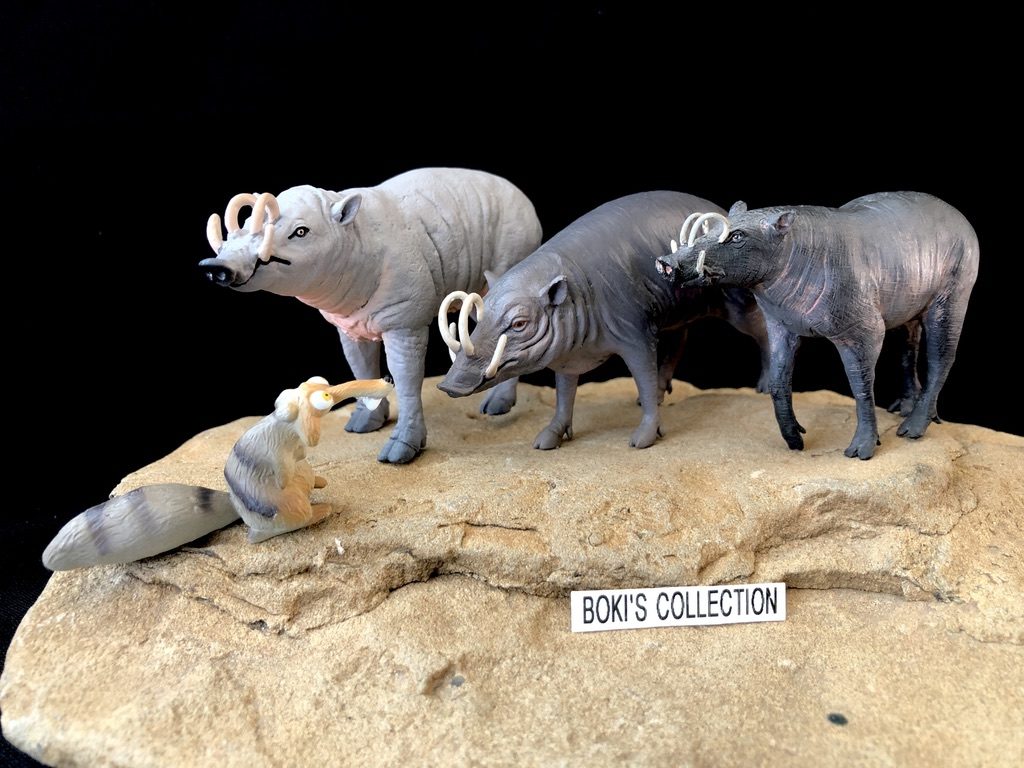
Despite having a catchy exotic name that is easy to pronounce, and a physical appearance that is both unique and unforgettable, it is puzzling that the Babirusa never did reach the level of fame that some of the other wild pigs had.
Babirusa, also commonly known as deer-pigs, are a type of wild pig that is found only in the group of island chains specifically Sulawesi, Togian, and Buru in Indonesia.
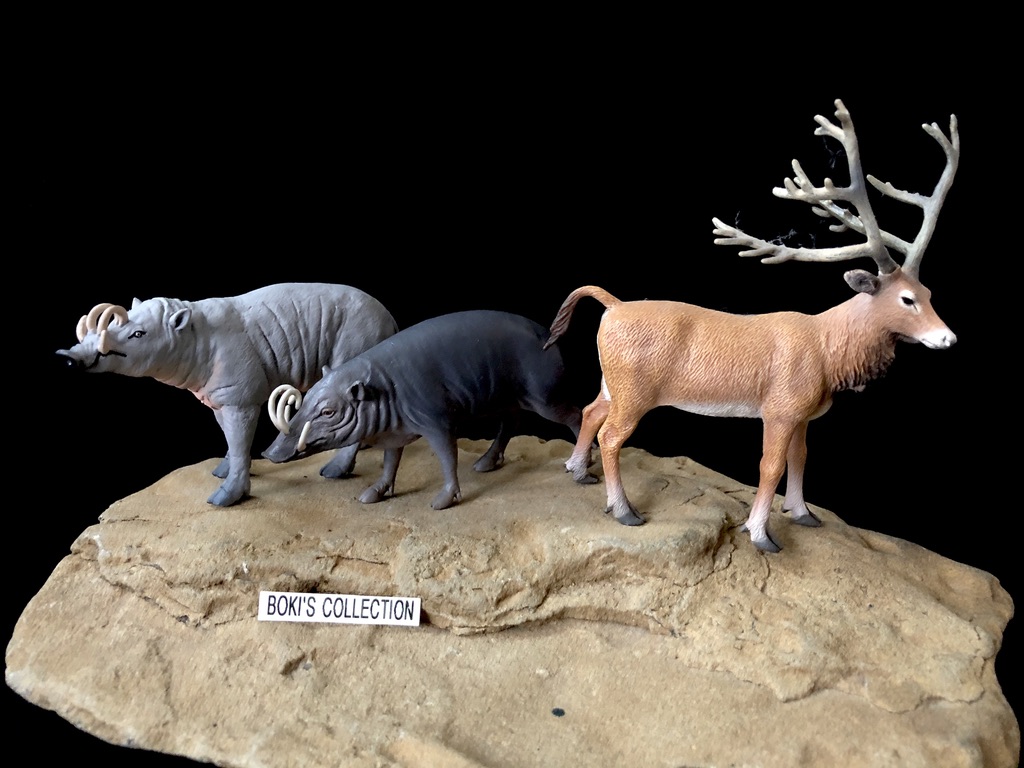
Physically, they look so prehistoric that one of these figure mixed in with prehistoric mammals will not look out of place. This appearance should help it appeal to those who collect prehistoric animals.
The most distinguished characteristics of Babirusa is it’s impressive curing tusk as well as the body almost appearing hairless.
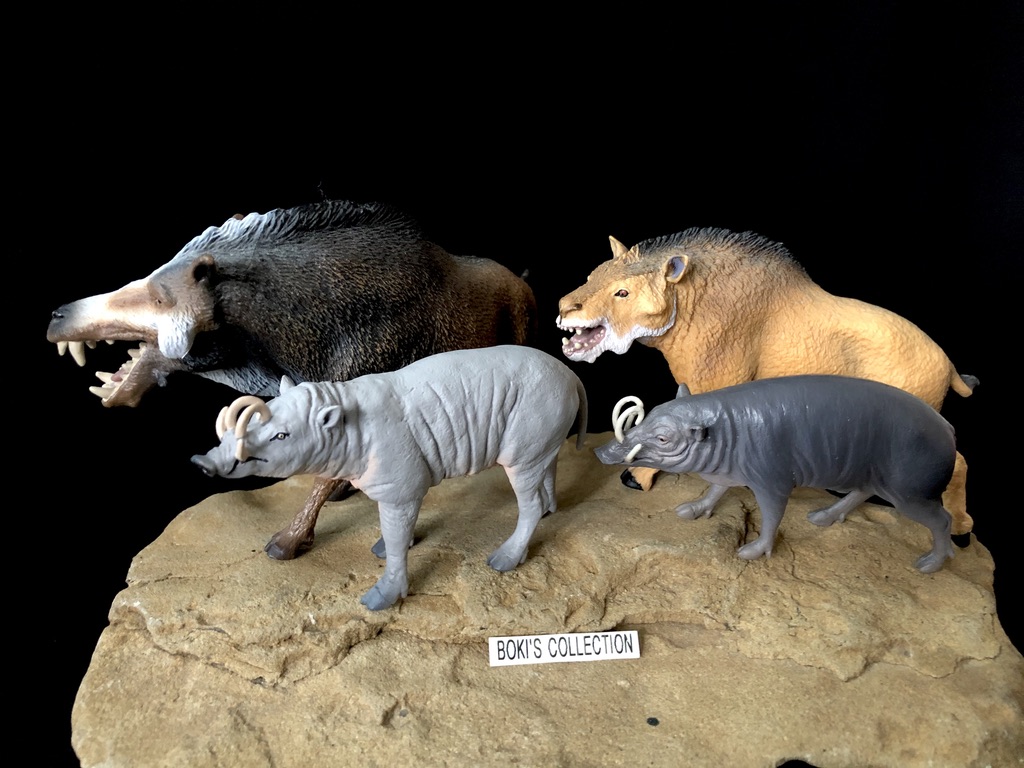
All members of the genus was, for along time, considered as a single species. Recently, in 2002 the group was split into four species: Buru Babirusa (B. babyrussa) also commonly known as the golden babirusa, the Bola Babirusa (B. bolabatuensis), North Sulawesi Babirusa (B. celebensis) also know as the Sulawesi babirusa, and the Tongian babirusa (B. togeanesis).
Babirusa’s preferred habitat are the tropical rainforest along river banks. With its restricted distribution and fast disappearing rainforest in these island chains, all babirusa species are now currently listed as threatened by the IUCN.
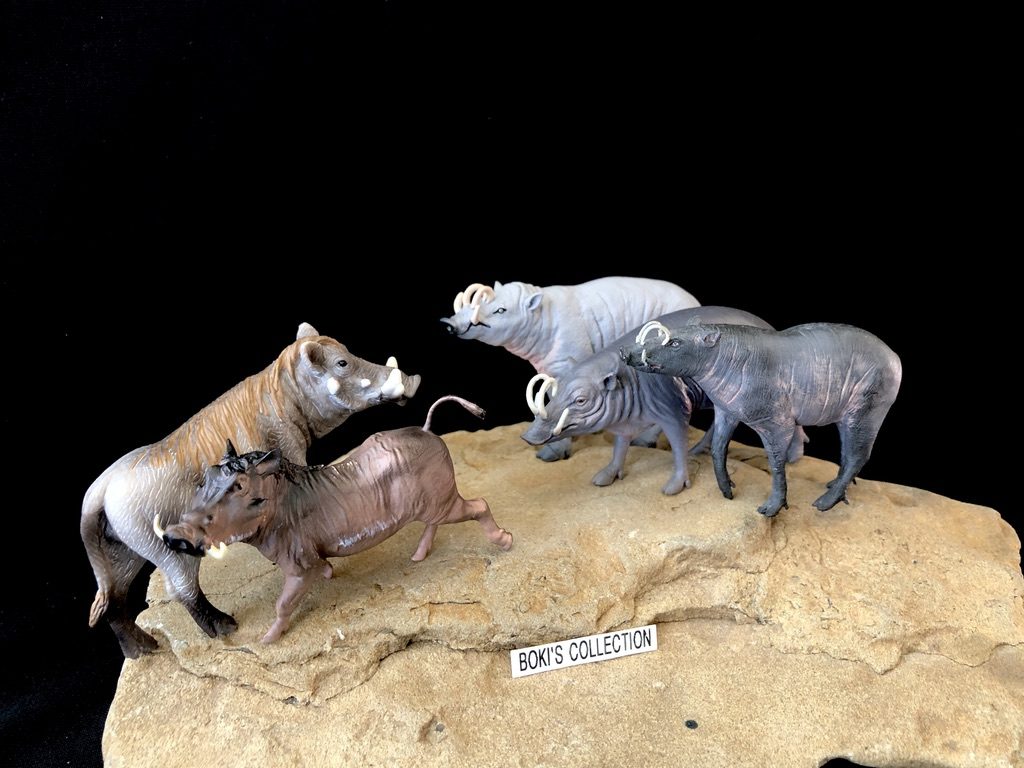
Although there are other wild pig species that possess impressive tusk, none of them match the shear drama and size of the babirusa’s.
The distinctive tusk are the only found on males. The first pair of tusk are the long upper canines that emerge vertically from the jaw, penetrating the skin, and curves backwards over the animals front head and towards its forehead. The second pair, the lower canines also grows upwards and curls backwards, but not as extreme as the upper ones.
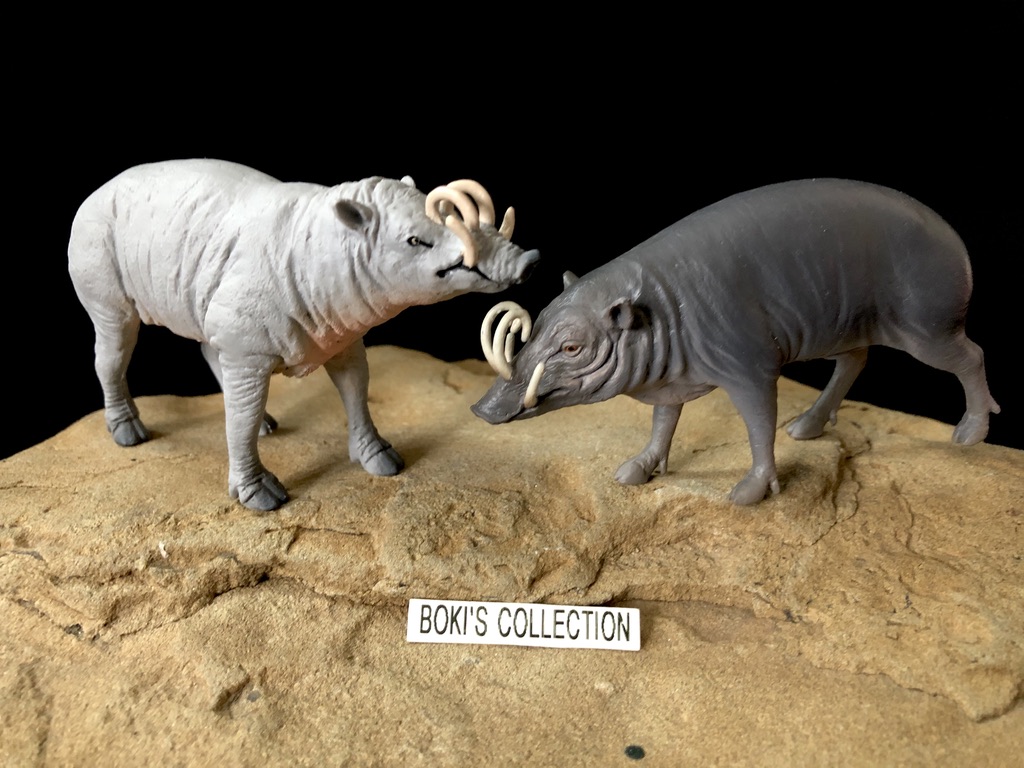
These impressive tusk are mostly for display, defense, and used as a weapon as well when males fight for dominance. These tusk continues to grow, and if they are not worn down through regular activity, these upper tusk will eventually penetrate the animal’s own skull, potentially killing them.
The other characteristics that makes the Babirusa stands out is that the body is covered with very little hair to the point that the animal looks almost bald.
Of the four recognized species, the golden babirusa perhaps have the longest and most visible body hair, and lighter in color.
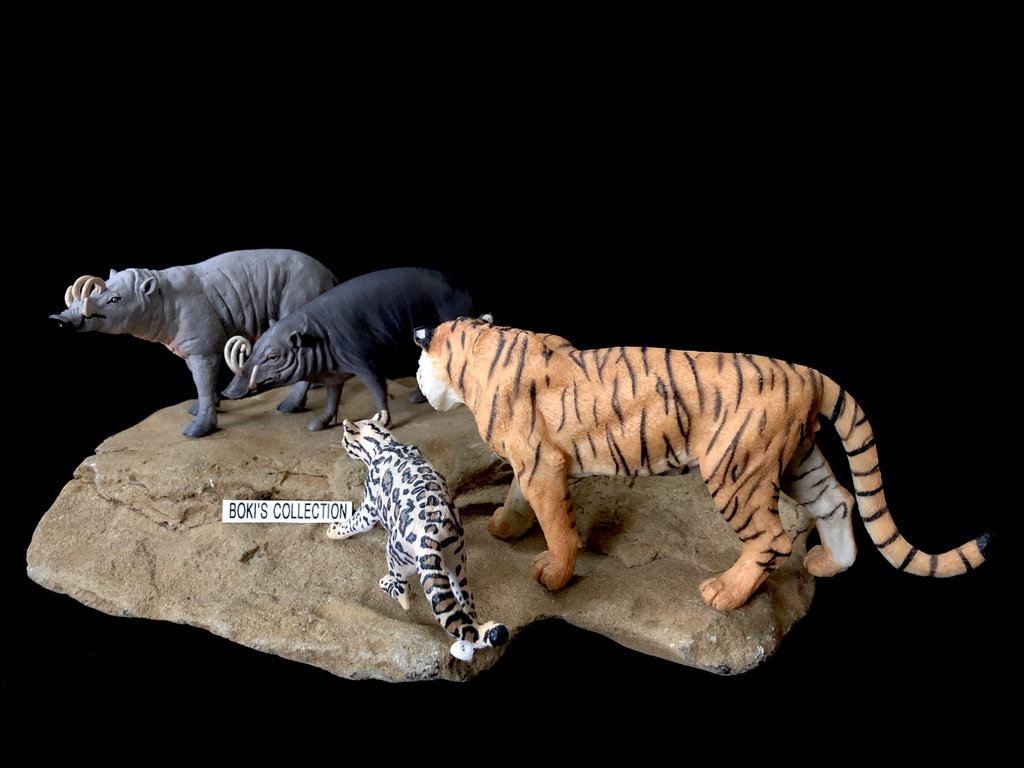
So, let’s meet the three little pigs, shall we? I will start with the oldest to the newest in term of release.
Bestiari’s Babyrousa celebensis or the Sulawesi babirusa- This figure is a limited edition resin figure sculpted by Joan Milelire Soler, who happens to also be a member of the ATF. Although not mass produced, and as far as I know, this was the first model of this species to be available. It was released in 2014.
Bestiari is the name of Joan’s line of mostly extant animals, and I was lucky enough to have most of them. It is a one-man production: from design, sculpting, casting, and painting. The labor intensive process is one of the reason that figures from this line are often limited editions , my figure happens to be # 6 of 16.
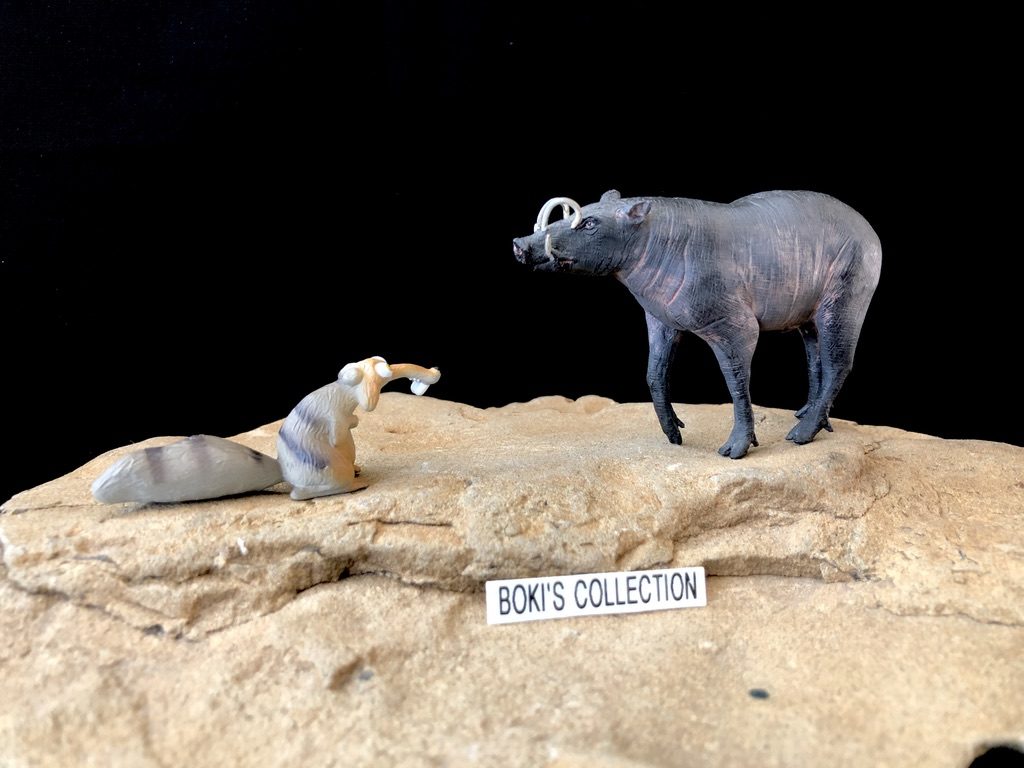
It is a beautiful model and really captures the delicate features of the animal. The distinctive tusk are so thin and delicate, sculpted in free-standing, meaning it does not touch the forehead for stability.
The model measures 3” inches long and 2” inches tall, it is the smallest of the trio.
Despite its small size, it is rich in delicate details. The body captures the almost naked appearance of the species, but there are plenty of visible skin folds, especially in the neck, stomach, and hind area of the body.
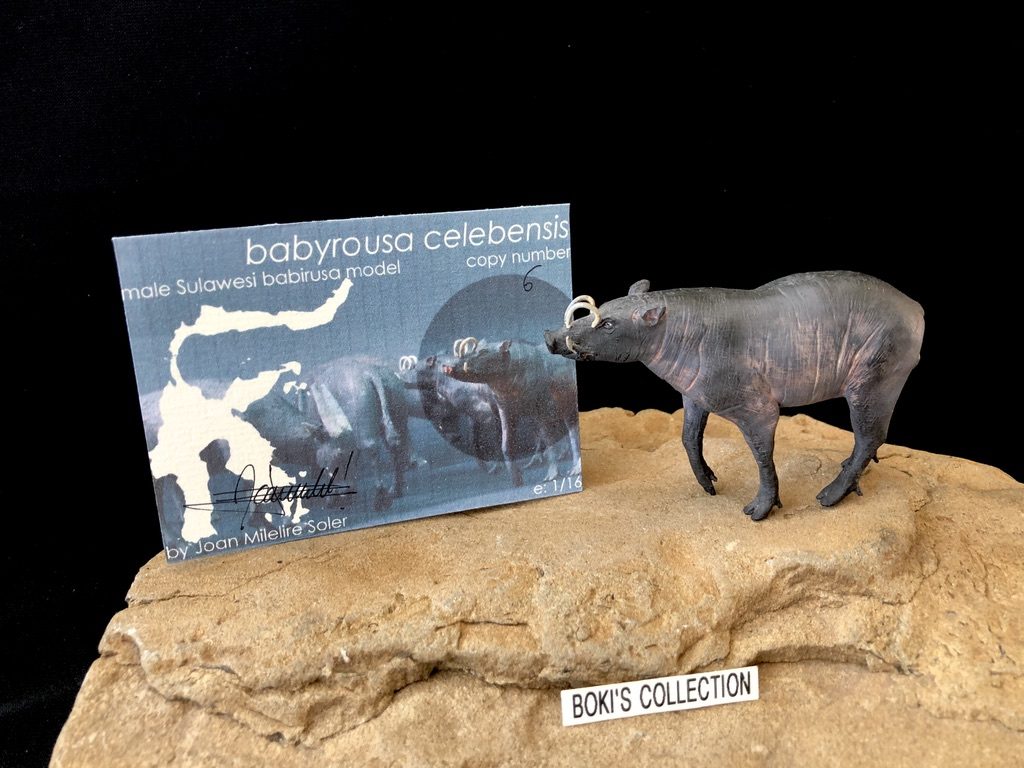
The eyes is so small and yet you can see that it is colored yellow and you can see the very small pupil, a truly impressive paint job.
The overall body color is black/dark brown. On the neck, belly, and rump you see some pinkish color dry-brushed on top to give the effect of some lighter skin blotches, which is really nice and adds some realism to it.
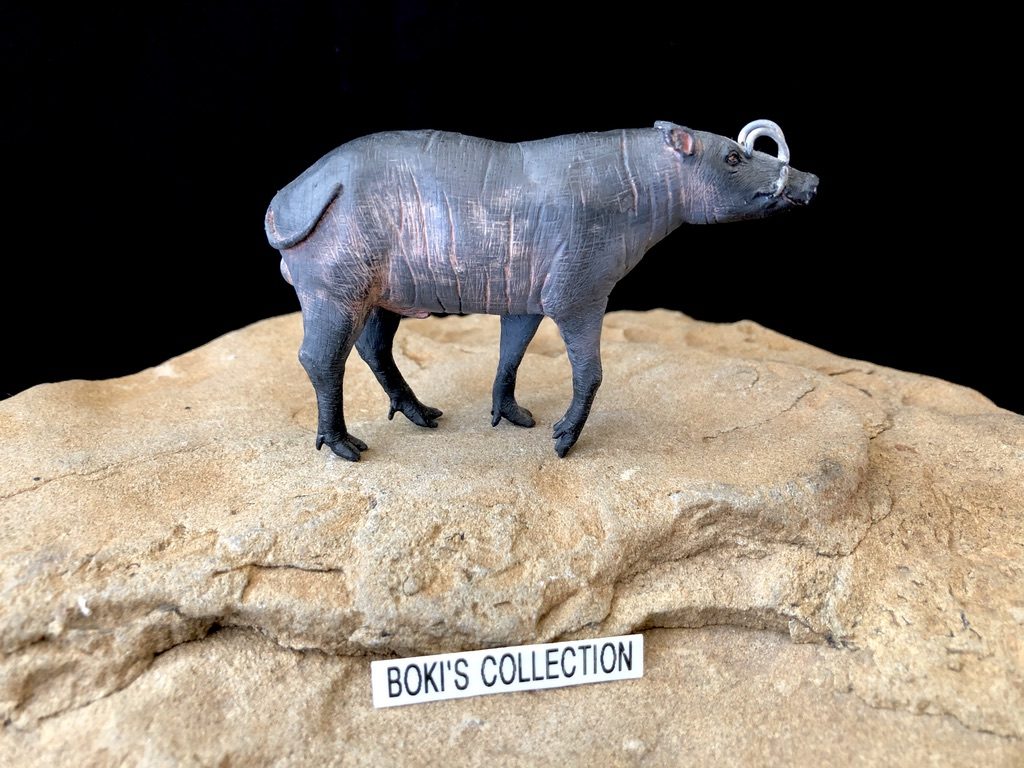
This is clearly a male based on the tusk, but looking behind, you can see a very pronounced “sac” just under the tail. The tail itself is sculpted attached to the body, obviously to prevent breakage, and is curved sideways.
The figure is well proportioned and looks like a well-fed individual.
The tiny hooves are delicate and full of details. The figure is sculpted in a calm walking pose.
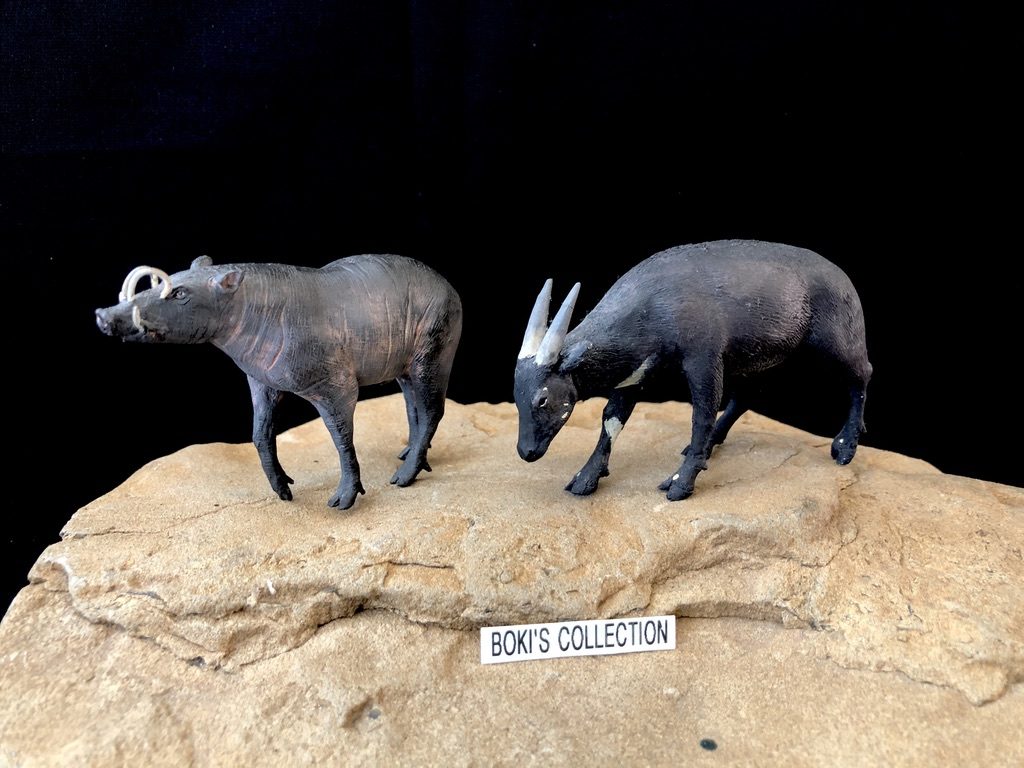
Joan also sculpted a male Lowland anoa, a small species of buffalo, for the line and it makes a great companion for his babirusa figure.
CollectA Babirusa- In 2015 we got our first ever truly mass produced babirusa figure when CollectA released their version. By now, no one should be surprise that CollectA takes the lead when it comes to producing obscure and unique species.
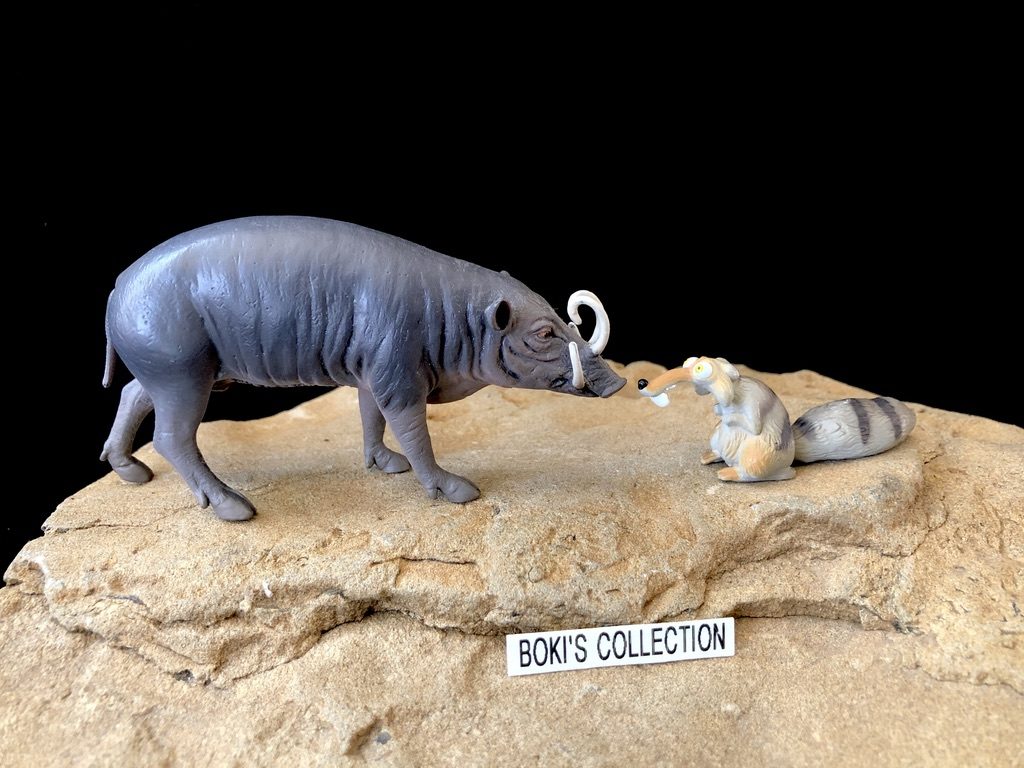
I was very excited when I learned that CollectA was releasing a babirusa figure since its always been on my wish list.
Based on the looks, it seems that this figure is also the Sulawesi species. It’s a great figure and also captures the essence of that species.
The figure measures 3.5” inches long and almost 2.5” tall, so it is slightly bigger than the first figure, but it looks good as a companion for it.
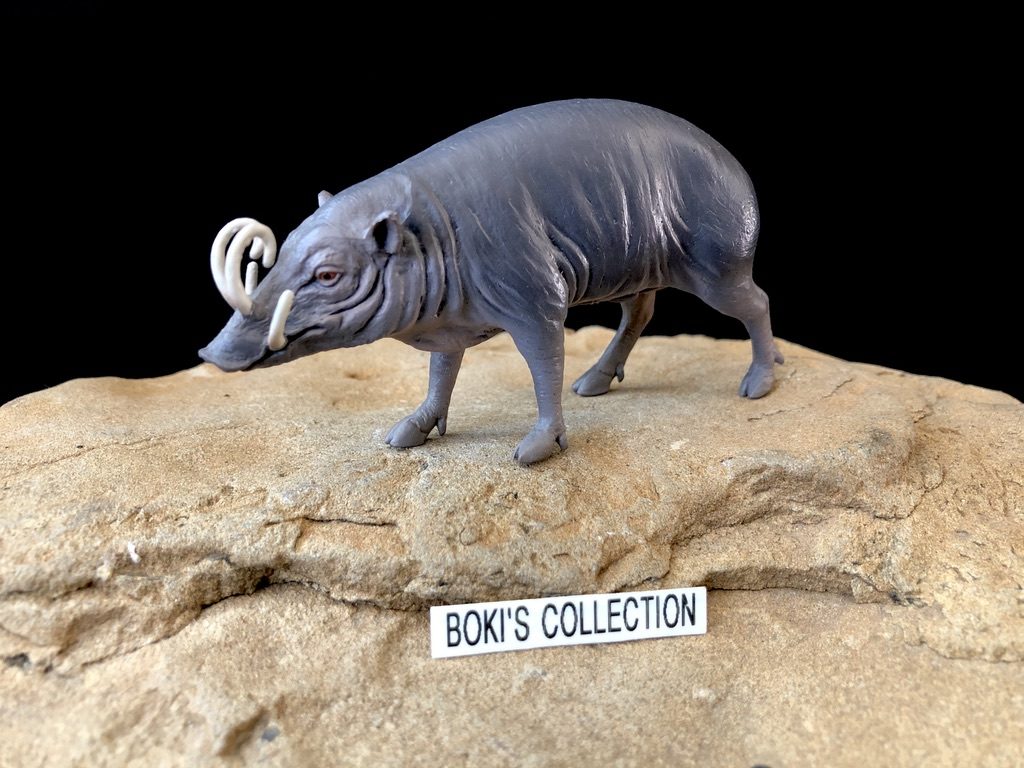
CollectA also sculpted the impressive tusk in a free-standing style, so you can really appreciate the the long curving tusk. As is the case with many “pointed tips”, these tusk are blunted for safety, so they look a little rounded, but not bad.
This figure also nicely captures the almost naked look of the species and the glossy paint make it looks like wet skin as if the animal just got up from a wallow.
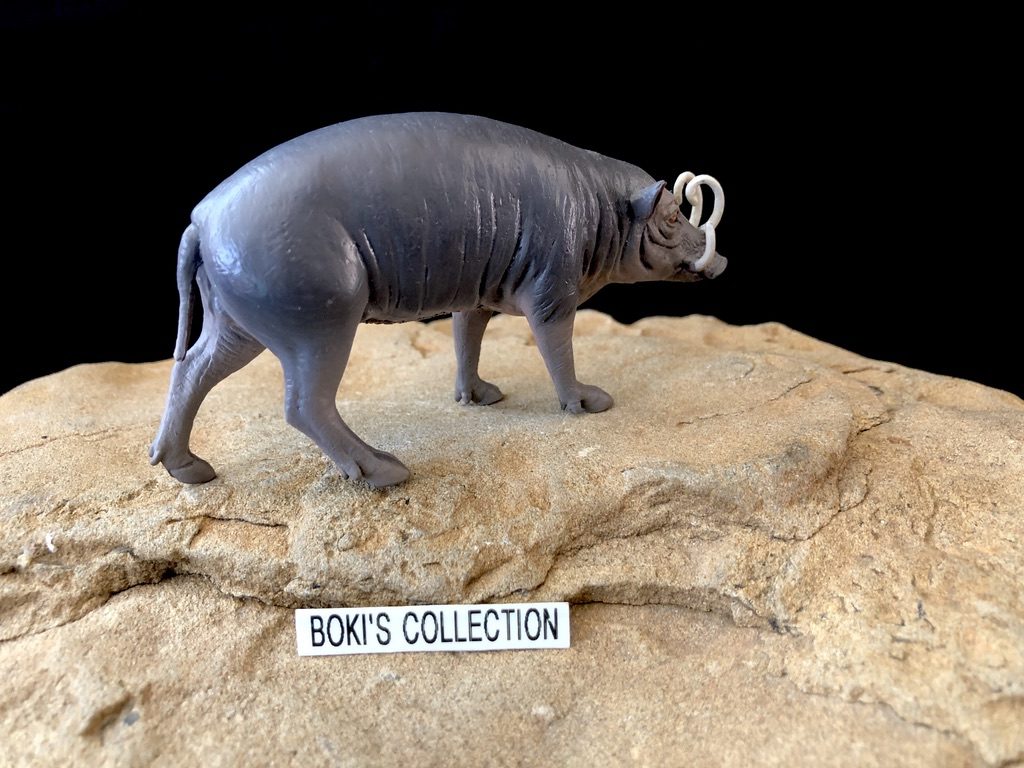
The figure is also rich in detail from head to the rest of the body. You can see many skin folds and wrinkles.
The eyes are also small, but well painted in yellow with the pupils painted precisely despite the small size.
The overall body color is dark gray, almost black. There are highlights of lighter colors on the neck, body, belly, and rump areas that really adds a nice depth to the entire figure. The paint job is clean and natural looking, not thickly applied that it obscures the delicate details.
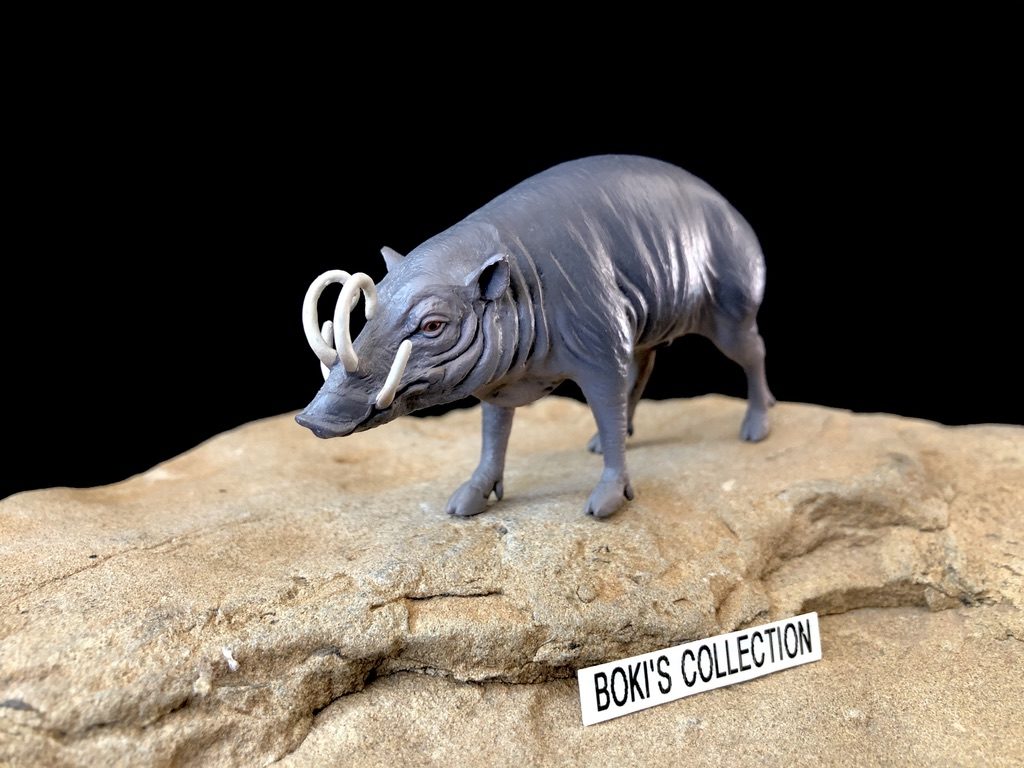
The figure is also sculpted in a relaxed walking pose. The hooves are nicely done as well.
The tail is long and hairless, and have lots of wrinkles and is not sculpted attached tot he body.
Overall a great, natural looking figure that I highly recommend.
Safari Babirusa – The third figure is from Safari and was released in 2018, 3 years after CollectA’s. Unlike the two previous figures, this version looks slightly different.
To me, the looks fits more like that of the Buru babirusa (B. babyrussa) also commonly known as the golden babirusa. But that’s just me.
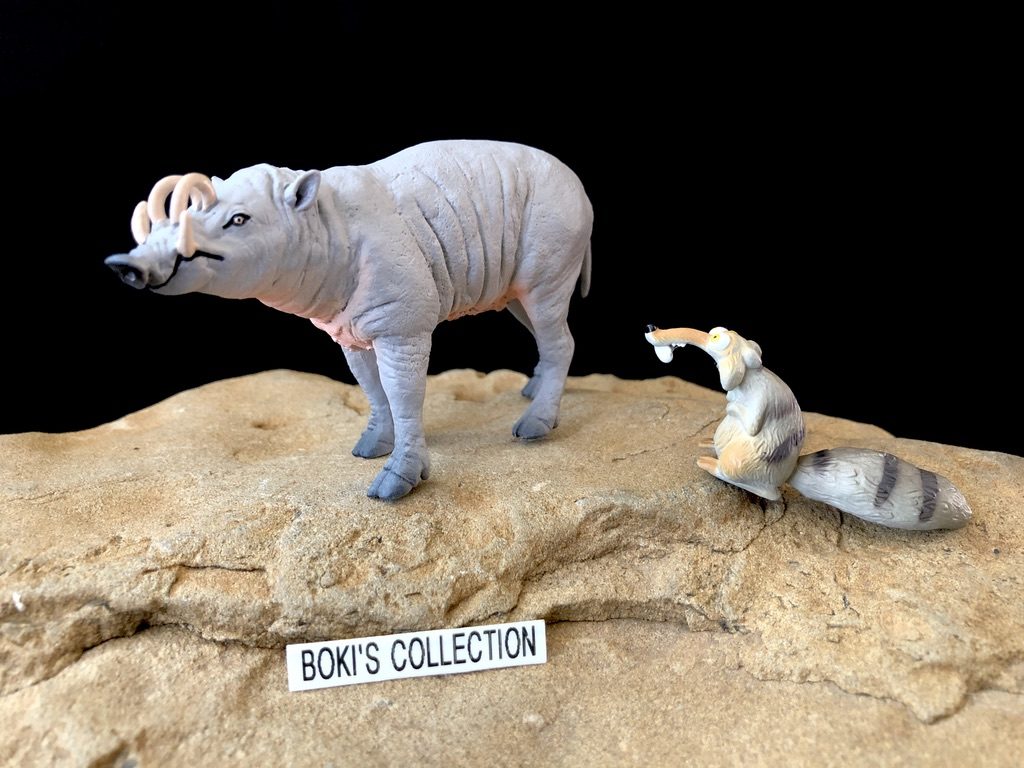
This is the largest of the trio, measuring almost 4” inches long and almost 2.5” inches tall. Unlike the first two figures, this one is colored light gray and not black.
In this figure, we see the extreme case of the upper tusk curing into the forehead. I’m not sure if this was supposed to be just touching or had already penetrated the skull, but the long curving tusk are attached to the forehead unlike the other two.
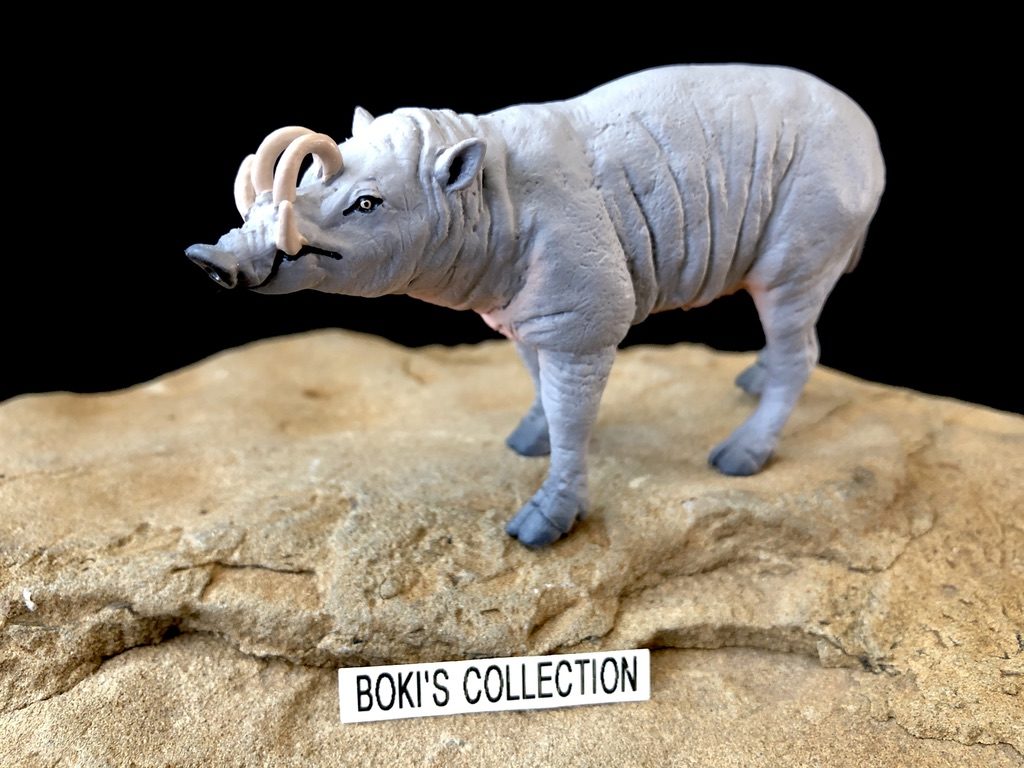
Proportionally, the legs on the figure looks longer compared to the other two. The gray body color is a little thick, and with the lighter tone, it tends to obscure many of the beautiful and delicate details. You have to look really close to appreciate some of the wrinkles and skin folds. But there is enough bigger folds that remains visible so the figure doesn’t look too flat.
There is hardly any color highlights the body until you reach the belly area, here you see a pinkish orange colors that split the gray and looks nice.
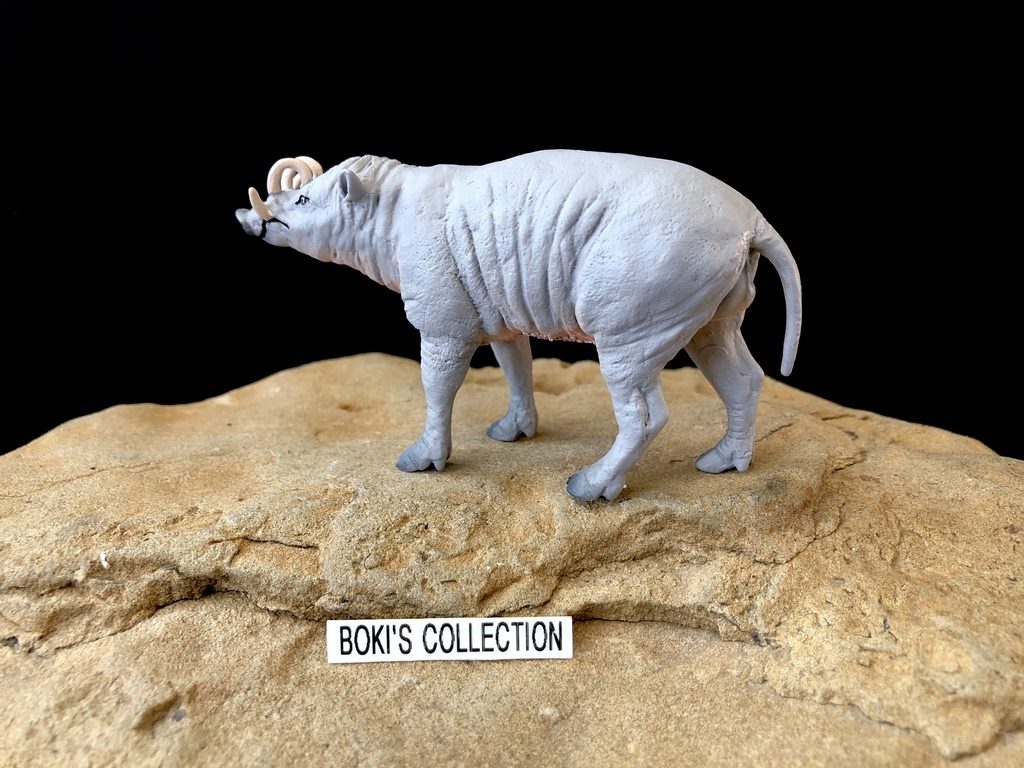
The pose is standing still and alert with the head slightly raised. The hooves are bigger looking compared to the other two. The tail is also longer and fatter and sticks out from the body. The eyes are small and painted cleanly in yellow with the pupils visible.
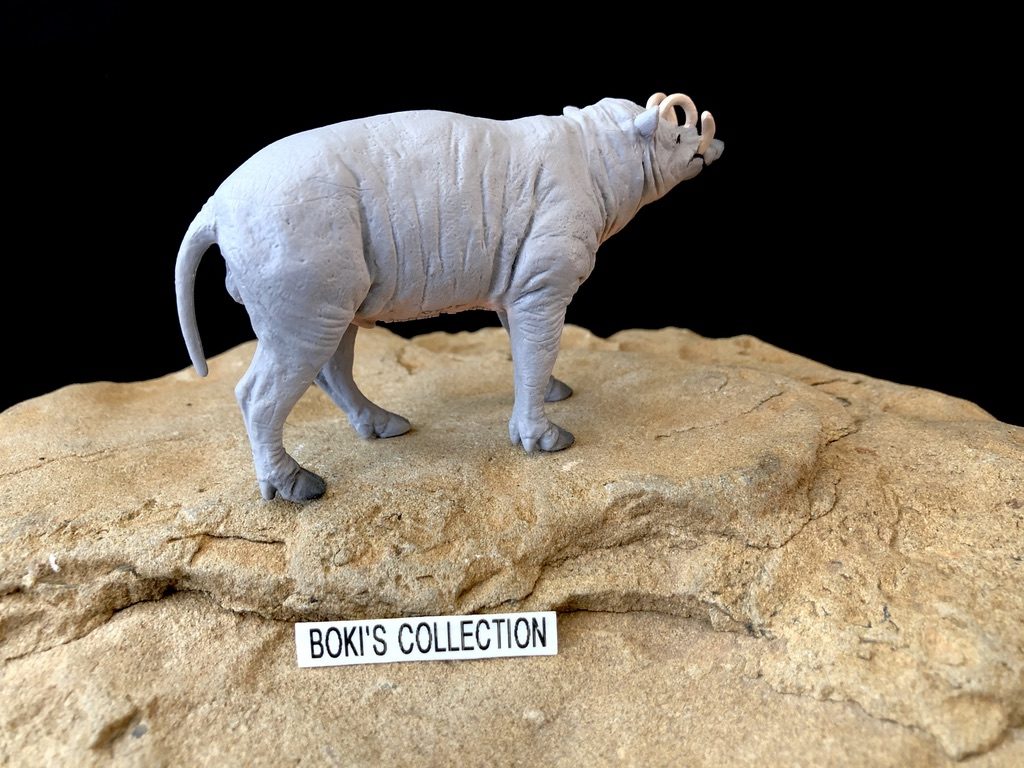
Overall a nice figure, but one thing that I find really destructing is how they painted a dark outlines on the eyes (looks like it’s wearing a black eyeliner) and the mouth (black lipstick). To me, the outlines are so extreme. They could have diluted the black a little. This figure is from the first run, looking at some of the more recent ones, it looks like they have fixed, at least, they eye outline as it’s not so black anymore.

With figure representation in short supply, these trio of Babirusa figure is definitely worth acquiring. They are all beautifully sculpted figures, and a s a bonus, the slight differences in them can be attributed to different species.
I always find it fascinating to see how each sculptor/company’s interpretation of the same animal looks like side-by-side, and these trio makes a perfect study.
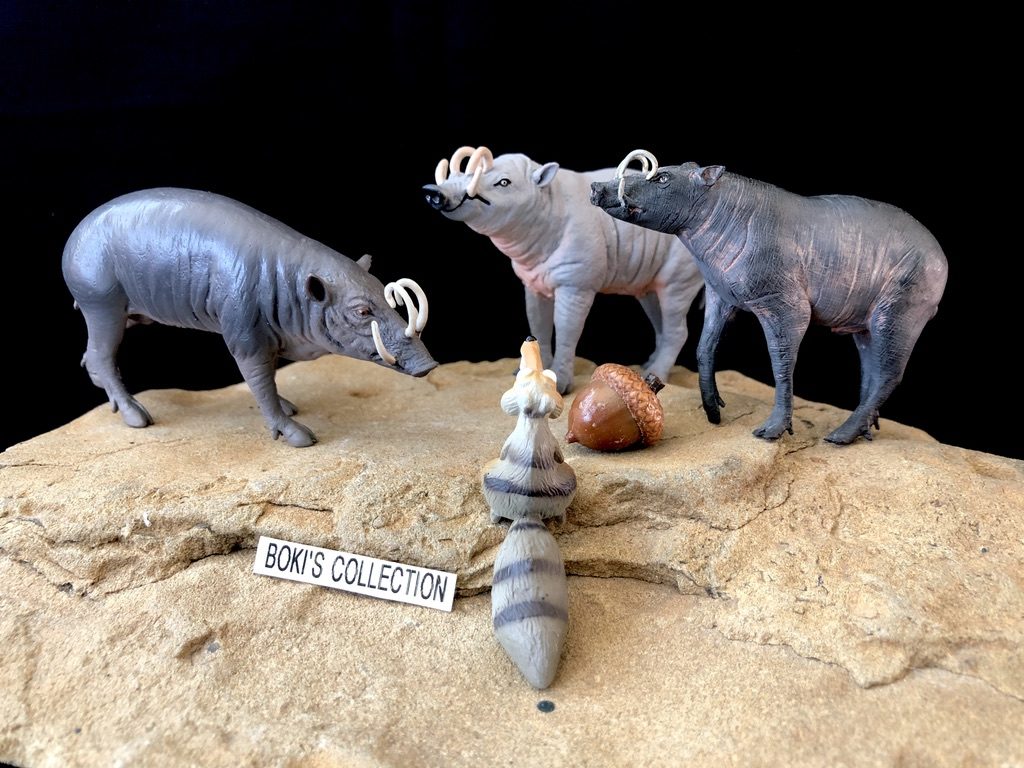
That concludes our review of the three little pigs today, and this also rounds up my Asian themed review for a while. Hope you all enjoyed it and thanks for reading the trio. Next time, we twill ravel all the way across the globe and explore the vast and beautiful continent of Africa! Until then, take care and cheers!
Disclaimer: links to Ebay and Amazon on the AnimalToyBlog are affiliate links, so we make a small commission if you use them. Thanks for supporting us!




What I nice, original way to present these figures! For my personal collection, I went with CollectA. I think there are 1-2 vintage representative of this species/genus too (TAI is down now so I can’t check).
I should point out, both the CollecA and Safari figures were intended to represent the Sulawesi babirusa, so all three of these are the same species. I suggest having the tags only reflect the one species shown here (and the genus, of course). Doug Watson, who sculpted the Safari figure, said his intentionally is to represent a specimen whose tusks go back into the skull!
Actually what I said on the ATF about the tusks was “The tusks can often reach the surface of the head and in some cases penetrate the skull, mine is meant to just reach the top of the head the tips have not been painted very well on this example, they continue to curve under. ”
The specimen that I used for reference had one tusk that curved under just touching the skin the other cleared the skin. I made them both touching but not meant to be penetrating the skull as they can. The paint application makes them look like they are under the skin.
thanks for the clarification Doug (I was going on memory there). And welcome to the Blog! Hope you enjoy seeing some of your work here! 😀
Most of the time I do enjoy seeing what people think of my pieces. Of course I prefer it when they like them but informed critique is also helpful.
I see more of my stuff on the DTF than the ATF.
I have no doubt that this blog will eventually be brimming with more of your stuff.
I really enjoyed this comparison entry, your pictures and very helpful comments. I also have a little preference for CollectA’s babirusa once Joan’s figure is not exactly a direct competitor. I hope to see more entries like these with your rich observations, from the wrincles, tail, eyes, etc. I believe you are aware that Starlux made a babirusa much before these brands.
Nice review format Boki/OkapiBoy. Once accounting for the fact that Bestiari’s figure isn’t really in competition with the other two, I agree with Blaine and Roger that CollectA’s is the best version of this species, although I do like the skull-penetrating upper tusks of the Safari version.
I wished all sculptors were like Doug and could give to us some really interesting explanations about their sculptures.
I forgot to mention that before Starlux, Elastolin made a babirusa, almost 100 years ago and it is not listed at Toy Animal Wiki but it can be seen on STS. I wished I had one of these. 😉